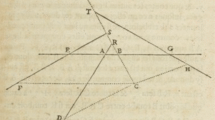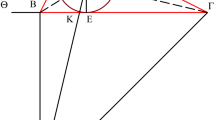Abstract
The present article discusses remarks and suggestions made by Andrew Meyer and Dennis Schilling on a previous contribution of the author. It assesses the status of the root-branches analogy in the Huainanzi 淮南子, and the compatibility of the said analogy with the composition of the same work as a ring composition. It also discusses the numerology proper to the Huainanzi in view of the principles provided by the Yijing 易經. It compares the structural arrangements of the Huainanzi with the ones found in the various versions of the Daodejing 道德經. It concludes on the relationship that these two works establish between the understanding the Way (dao 道) and knowledge about shapes and numbers.
Similar content being viewed by others
References
Allan, Sarah. 1997. The Way of Water and Sprouts of Virtue. Albany: SUNY Press.
Allan, Sarah, and William Crispin, eds. 2000. The Guodian Laozi 郭店楚簡《老子》: Proceedings of the International Conference, Dartmouth College, May 1998. Early China Special Monograph Series. Berkeley: Society for the Study of Early China and Institute of East Asian Studies, University of California.
Boltz, William G. 2005. “The Composite Nature of Early Chinese Texts.” In Text and Ritual in Early China, edited by Martin Kern. Seattle: University of Washington Press.
Brindley, Erica Fox. 2012. Music, Cosmology, and the Politics of Harmony in Early China. Albany: SUNY Press.
Chemla, Karine, ed. 2012. The History of Mathematical Proof in Ancient Traditions. Cambridge: Cambridge University Press.
Chemla, Karine, and Guo Shuchun, trans. and ed. 2004. Les neuf chapitres: Le classique mathématique de la Chine ancienne et ses commentaires. Paris: Dunod.
Cullen, Christopher. 2016. “The Suan Shu Shu, ‘Writings on Reckoning’: Rewriting the History of Early Chinese Mathematics in the Light of an Excavated Manuscript.” Historia Mathematica 34: 10–44.
Ding, Sixin 丁四新. 2016. “A Study of the Key Concepts ‘Heng’ and ‘Hengxian’ in the Hengxian on Chu Bamboo Slips Housed at the Shanghai Museum.” Frontiers of Philosophy in China 11.2: 206–221.
______. 2019. “Huo 或 in Heng Xian of the Shanghai Museum’s Edition of Chu Bamboo Slips.” Journal of Chinese Philosophy 46.3–4: 182–190.
Douglas, Mary. 2007. Thinking in Circles: An Essay on Ring Composition. New Haven: Yale University Press.
Feng, Lisheng. 2017. “On the Structure and Functions of the Multiplication Table in the Tsinghua Collection of Bamboo Slips.” Chinese Annals of History of Science and Technology 1.1: 2–23.
Gentz, Joachim, and Dirk Meyer, eds. 2015. Literary Forms of Argument in Early China. Leiden: Brill.
Granet, Marcel. 1934/1999. La pensée chinoise. Paris: Albin Michel.
Henricks, Robert G., trans. 2000. Lao Tzu’s Tao Te Ching: A Translation of the Startling New Documents Found at Guodian. New York: Columbia University Press.
Hunter, Michael, and Martin Kern, eds. 2018. Confucius and the Analects Revisited: New Perspectives on Composition, Dating, and Authorship. Leiden: Brill.
Kern, Martin, ed. 2005. Text and Ritual in Early China. Seattle: University of Washington Press.
L’Haridon, Béatrice, trans. 2017. Meou-Tseu [Mouzi] 牟子, Dialogues pour dissiper la confusion 理惑論. Paris: Les Belles Lettres.
Lebovitz, David J. 2021. “Molecular Incoherence, Continuity, and the Perfection of the Laozi.” Early China 44: 237–319. DOI: https://doi.org/10.1017/eac.2021.8.
Lynn, Richard J., trans. 1994. The Classic of Changes: A New Translation of the I Ching as Interpreted by Wang Bi. New York: Columbia University Press.
Major, John S., Sarah A. Queen, Andrew Seth Meyer, and Harold D. Roth, trans. and ed. 2010. The Huainanzi: A Guide to the Theory and Practice of Government in Early Han China. New York: Columbia University Press.
Meyer, Andrew. 2014. “Root-Branches Structuralism in the Huainanzi.” In The Huainanzi and Textual Production in Early China, edited by Sarah A. Queen and Michael Puett. Leiden: Brill.
Meyer, Dirk. 2012. Philosophy on Bamboo: Text and the Production of Meaning in Early China. Leiden: Brill.
______. 2021. Documentation and Argument in Early China. The Shangshu 尚書 (Venerated Documents) and the Shu Traditions. Berlin and Boston: De Gruyter / Mouton.
Pelkey, Jamin. 2021. “Zhuangzi, Peirce, and the Butterfly Dreamscape: Concentric Meaning in the Qiwulun.” Chinese Semiotic Studies 17.2: 255–287. DOI: https://doi.org/10.1515/css-2021-0013.
Queen, Sarah A., and Michael Puett, eds. 2014. The Huainanzi and Textual Production in Early China. Leiden: Brill.
Shaughnessy, Edward L. 2005. “The Guodian Manuscripts and Their Place in Twentieth-Century Historiography on the Laozi.” Harvard Journal of Asiatic Studies 65.2: 417–457.
Vermander, Benoît. 2021. “Edit by Number: Looking at the Composition of the Huainanzi, and Beyond.” Dao: A Journal of Comparative Philosophy 20.3: 459–498. DOI: https://doi.org/10.1007/s11712-021-09790-z.
______. 2023. “Confucius and the Hen-Pheasant: The Enigma at the Center of the Analects.” Dao: A Journal of Comparative Philosophy 22.3.
Wagner, Rudolf. 2000. The Craft of a Chinese Commentator: Wang Bi on the Laozi. Albany: SUNY Press.
______. 2003. A Chinese Reading of the Daodejing: Wang Bi’s Commentary on the Laozi with Critical Text and Translation. Albany: SUNY Press.
Yang, Liuqiao 楊柳橋, ed. and trans. 2007. The Zhuangzi, Annotated and Translated 莊子譯註. Shanghai 上海: Shanghai Guji Chubanshe 上海古籍出版社.
Yang, Tiancai 楊天才, and Zhang Shanwen 張善文, eds. 2011. Classic of Change 周易. Beijing 北京: Zhonghua Shuju 中華書局.
Zürn, Tobias. 2020. “The Han Imaginaire of Writing as Weaving: Intertextuality and the Huainanzi’s Self-Fashioning as an Embodiment of the Way.” The Journal of Asian Studies 79.2: 367–402.
Declaration
The author declares that there is no conflict of interest.
Author information
Authors and Affiliations
Corresponding author
Additional information
Publisher's Note
Springer Nature remains neutral with regard to jurisdictional claims in published maps and institutional affiliations.
Rights and permissions
Springer Nature or its licensor (e.g. a society or other partner) holds exclusive rights to this article under a publishing agreement with the author(s) or other rightsholder(s); author self-archiving of the accepted manuscript version of this article is solely governed by the terms of such publishing agreement and applicable law.
About this article
Cite this article
Vermander, B. Circling the Giant Tree: A Response to Andrew Meyer and Dennis Schilling. Dao 22, 647–658 (2023). https://doi.org/10.1007/s11712-023-09911-w
Accepted:
Published:
Issue Date:
DOI: https://doi.org/10.1007/s11712-023-09911-w




